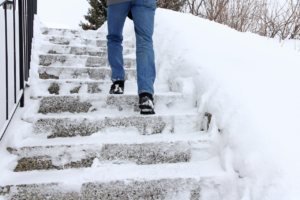 According to a 2016 WSIB report, 42,000 workers get injured in Canada annually as a result of a slip, trip, or fall while on the job. These types of injuries account for 18% of all lost-time injuries. So, not only are slips, trips, and falls dangerous to worker health, but they are also costly to employers. Preventing slips, trips, and falls is all about good housekeeping, which should be an important part of every workplace’s safety program.
According to a 2016 WSIB report, 42,000 workers get injured in Canada annually as a result of a slip, trip, or fall while on the job. These types of injuries account for 18% of all lost-time injuries. So, not only are slips, trips, and falls dangerous to worker health, but they are also costly to employers. Preventing slips, trips, and falls is all about good housekeeping, which should be an important part of every workplace’s safety program.
General Duty
Employers are responsible for protecting their workers from slips, trips, and falls. We talk about slips, trips, and fall prevention in January because due to our Canadian winters, known for treacherous snowy and icy weather, the risk for an injury is higher. Section 25 of the Occupational Health and Safety Act includes what’s known as the “general duty clause.” It states that employers must “take all reasonable precautions in the circumstance to protect the health and safety of workers.” This includes protections from hazards that may result in a slip or trip, and from hazards resulting from a fall on the same level, or from heights.
Ontario Regulation 851
Ontario Regulation 851, Section 11, sets out explicit responsibilities for employers when it comes to housekeeping and the prevention of slips and trips in the workplace:
“A floor or any other surface used by any worker shall be,
(a) be kept free of,
(i) obstructions,
(ii) hazards, and
(iii) accumulations of refuse, snow or ice; and
(b) not have any finish or protective material used on it that is likely to make the surface slippery.
This means that shovelling snow, salting icy sidewalks, and ensuring that walkways are clear during the winter must be part of your organization’s general housekeeping accountabilities.
Preventing Slips and Trips and the Workplace
While employers hold primary responsibilities, everybody in the workplace plays a role in slip and trip prevention. There are many ways that workers, supervisors, managers, and employers can work together to practice good housekeeping and reduce slips and trips in the workplace, such as:
- Ensuring that trip hazards are removed or corrected when they’re spotted
- Reporting potential slip and trip hazards to supervisors
- Putting salt down on icy walkways
- Shovelling high-traffic areas and entryways frequently during snowfall
- Keeping low filing cabinet drawers, dishwasher doors, and low storage cupboards closed when not in use
- Using signage to indicate wet floors
- Having sound housekeeping policies in place that prohibit clutter, boxes, or rubbish in walkways
Do you need help writing or updating your housekeeping policy? Contact BEST Safety Training and Consulting. We can help!
Preventing Falls
Ontario Regulation 213 for Construction Projects contains information about the prevention of falls from heights. Like slips and trips, fall prevention involves all workplace parties, and there are many ways to work together to prevent falls, such as:
- Asking questions before starting a job at heights
- Using equipment, such as ladders and mobile lifts, correctly
- Donning appropriate PPE for the job
- Reporting potential fall hazards and defects in equipment
Slips, Trips, and Falls Training
Training is an essential component of a workplace slip, trip, and fall prevention program. In fact, fall prevention training is so important that it’s now regulated in Ontario, as set out in Ontario Regulation 297. The Ministry of Labour’s decision to regulate working at heights training in Ontario is in response to the high number of work-related fatalities resulting from falls. The aim is to reduce or eliminate fall fatalities in Ontario through fall prevention training. Contact us to sign up for Slips, Trips, and Falls eLearning today!
Working at Heights Training
All workers who work from heights require training on how to use fall protection equipment, care and inspection, rescue procedures, and any other fall protection knowledge that may apply to the work. The more information your employees have about the dangers of working at heights, the more likely they are to complete the job safely. Plus, working at heights training is the law! It’s found in several locations through the Occupational Health and Safety Act and Regulations.
BEST Safety Training is a CPO-approved provider of Working at Heights (Construction, Industrial, and Refresher) training and Working at Heights Train-the-Trainer – Industrial.
See upcoming Working at Heights Training Courses in your area!
Not Sure Where to Start? BEST Safety Training Can Help
Download this FREE Setting Housekeeping and Slip, Trip, and Fall Prevention Calendar, courtesy of BEST Safety Training and Consulting.
Like the calendar? Add your email to our mailing list to get one FREE, straight to your inbox, every month. Each month features a new topic, all designed to keep your workplace safe, healthy, and compliant.
See all onsite and virtual learning coming soon to your area!
To ask questions about our training programs or to book a consultation to help you develop a customized working at heights safety program contact us online or call 226.777.7385. Visit us 24/7 on the web at bestsafetytraining.ca.
